The commercial grade pressure gauge typically costs $10-$30, is considered small and made from brass/bronze wetted materials. You would use the commercial grade gauge for light duties such as gauging pool filters, tire pressure gauge, sprinkler systems and more. The accuracy tolerance for this specific gauge is around +2-3% of span with the dial size being anywhere from 1.5” to 4.5”. The pressure range will be on the lower end since this gauge is cheaper, so you could expect it to range from 0-100psi.
Specification & Buying Guides
- Guide: Regular Industrial Pump Maintenance Avoids Costly Pump Repairs
-
Guide: How to Specify and Select Pressure Gauges
- Guide: How do Seal Pots and Seal Support Systems Work?
- Guide: How to Specify and Select a Process Skids Supplier
- Guide: How to Specify Control Panels & Electrical Systems Integration Components
- Guide: Industrial Internet of Things & IIoT Wireless Network Systems
- Guide: How to Select Commercial Steam and Hydronic Products
- Guide: How to Prevent and Fix Leaking Pump Seals
- Guide: How to Select and Size Filtration & Strainers
- Guide: How to Select and Size a Heat Exchanger
- Guide: How to Select and Size Process Flow Control Valves
- Guide: Select and Size the Right Industrial Blower for your Applications
- Guide: Level Measurement Instrumentation Selection
- Guide: What are the Best Valves for Pulp & Paper Plants?
Guide: How to Specify and Select Pressure Gauges
Mechanical pressure gauge technology was invented 160 years ago, before the civil war! Despite innovations in electronic pressure measurement technology, mechanical pressure gauges are still the standard specified on process systems because they are not subject to power or, network outages and a good quality mechanical pressure gauge is more durable than an electronic pressure gauge
There are 4 different types of mechanical pressure gauges – commercial grade, industrial grade, critical process applications, and calibration gauges.
Commercial Grade Pressure Gauges
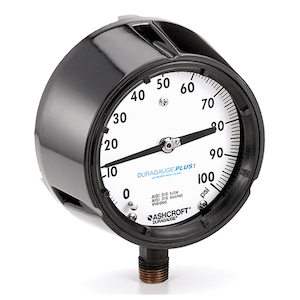
Industrial Grade Pressure Gauges
The industrial grade pressure gauge typically costs $30-$120, can be used for mid-size projects and is made of brass/bronze. You would use the industrial grade gauge for small panels, HVAC systems, hydraulic systems and even for natural gas distribution in residential areas. The accuracy tolerance for the gauge is +1-2% of span with the dial size being anywhere from 2.5”- 4.5”. The pressure range can really fluctuate for this price range but can go up to 3000psi.
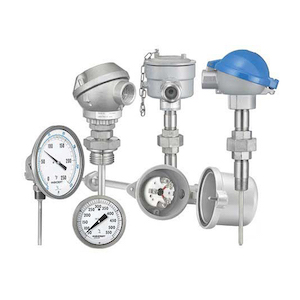
Critical Process Application Pressure Gauges
Critical process application pressure gauges cost around $100-$1500 and are larger in size. This type of gauge monitors water treatment plants, refineries, power/nuclear plants, etc. The accuracy tolerance for the gauge is +0.5-1% of span and is made with a variety of chemical resistant wetted materials. The dial size varies 4.5” or larger when it gets to this price range, but you can expect highly accurate measurements. The pressure range can reach up to 15000psi and again, it varies with this pressure gauge.
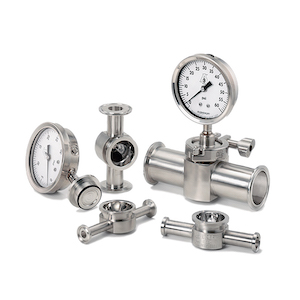
Calibration Gauges for Testing
Calibration gauges cost around $300-$1000 and is considered as a test standard for instrumentation testing and calibration. They are often used for aerospace and military equipment, laboratories, and field pressure. The test gauges must be four times as accurate as the instrument being checked so it will be extremely accurate (+0.1-025%) and will be more costly.
Pressure Gauge Accessories
There are many different accessories that can be added to pressure gauges. Some accessories like diaphragm seals or pressure limiting values can cost more than the initial pressure gauge. There are other accessories such as flow restrictors or isolations rings.
How Much Should a Pressure Gauge Cost?
There is no easy answer to how much a pressure gauge will cost. It varies depending on several factors.
- Type/Category
- Pressure Gauge Accuracy and Dial Size
- Pressure Gauge Range
- Pressure Gauge Options
- Pressure Gauge Accessories
Cost Data Source: Ashcroft.com
Pressure Gauge Type Cost Comparison
Lighter commercial/residential applications are usually smaller, open front cases with lightweight brass/ bronze systems and tend to be on the less expensive side.
Industrial equipment tends to use more expensive pressure gauges that have stainless steel cases and systems and better accuracy. These gauges are also generally smaller, 2.5 or 3.5-inch dial sizes.
Applications with continuous process monitoring are more robust in nature. The dial sizes usually expand to 4.5” or larger. They typically have better accuracy and a stronger focus on safety features such as a solid front style case or safety glass. Some require very specialized capabilities such as inert case fills, diaphragm seals with exotic wetted parts, or have to register extremely low readings with high static/ proof pressures requirements.
Test gauges are designed to check the calibration of other instruments. To comply with ASME standards the test gauges have to be four times as accurate as the instrument being checked. Therefore, test gauges have to be extremely accurate, and typically the more accurate the gauge the more it will cost
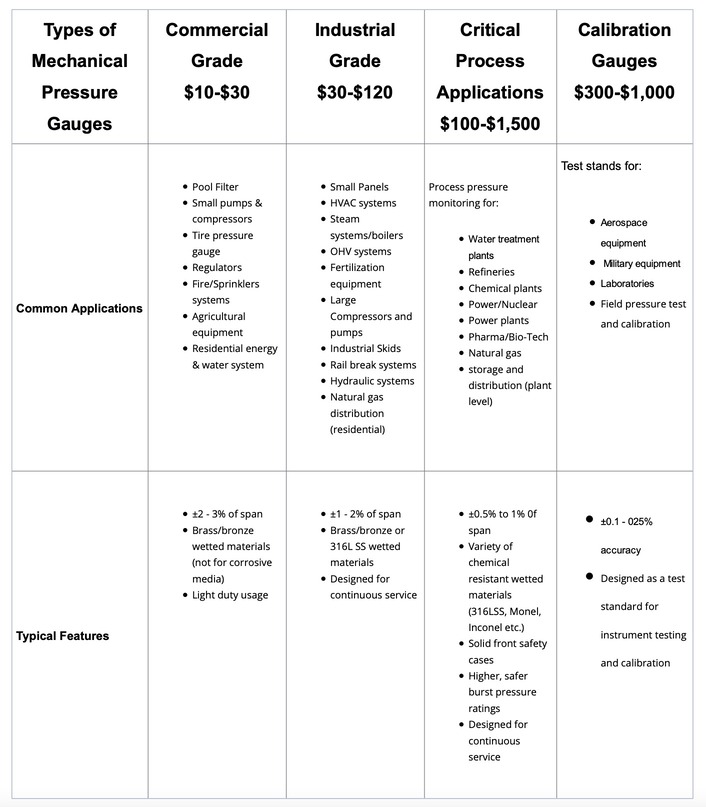
Pressure Gauge Accuracy and Dial Size
Depending on the application, accuracy can be very important. Generally, accuracy tolerances vary from ±0.1% to ±5%.
Typically, more accurate pressure gauges are more expensive. In part, this is because it takes longer for a manufacturer to calibrate an instrument to a tighter accuracy, as is the case of a test gauge. But, more commonly, upgrading to a pressure gauge with a better accuracy typically involves an upgrade to a new category of pressure gauges (e.g., moving from a commercial gauge to an industrial-grade gauge). In these instances, the more signi cant cost impact is upgrading the category versus just tightening up the accuracy.
The same can be said for increasing dial size. For example, going from a smaller 2.5 or 3.5-inch dial to a 4.5-inch or larger dial typically means upgrading to a more expensive category of gauges.
Pressure Gauge Range
Pressure gauges commonly have ranges from 0-30 psi through 0-600 psi. These ranges do not usually add cost, but if you have vacuum ranges and compound ranges (reading both vacuum and positive pressure) it can increase initial expense.
If you have very high-pressure ranges (1K-15Kpsi), the systems have to be more robust, and this will cost. In pressure ranges over 20,000 psi, a material with higher tensile strength like Inconel is usually required.
Conversely, some applications require very low pressure that can’t be registered by the traditional sensing elements found in a 0-15+ psi range. In those instances, different systems, such as bellows or capsule designs, are used. These require more time to calibrate and are costlier to manufacture. In some cases, applications require differential pressure readings with high static pressures but very low differential pressure readings. These can be costlier.
Pressure Gauge Options
The chart below shows common options that can impact your cost. These are categorized from “$” to “$$$$”: “$” typically being relatively inexpensive options versus “$$$$” typically being more expensive.
Pressure gauges can be supplied with a multitude of options for various reasons. Some are designed as safety features to protect the pressure gauge and/or operators. Some are designed for better visibility, or to prolong the lifespan of the pressure gauge.
Critical applications that involve hazardous chemicals often require more expensive options like calibration certificates, material traceability reports, or leak detection applications. In many cases, the more critical the application the more expensive the instrument configuration requirements tend to be.
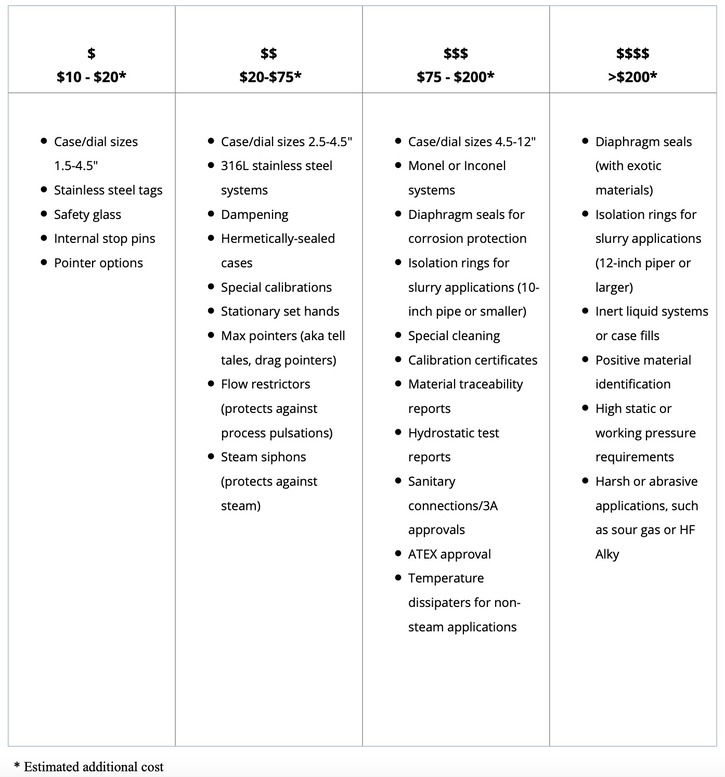
Pressure Gauge Accessories
Quite commonly pressure gauges are installed in harsh conditions. Under these conditions, pressure gauges can experience pulsation, vibration, extreme temperature, pressure spikes, clogging, and/or corrosion. In these instances, it is important, both for the lifespan of the pressure gauge as well as the safety of those who work with the equipment, that the gauges are adequately protected
Some accessories, such as flow restrictors, are not necessarily expensive. Others, such as diaphragm seals or pressure limiting valves can sometimes surpass the initial cost of the pressure gauge. In some cases, they can be one, two, or three times the cost of the gauge…or more
Diaphragm seals with exotic materials and expensive inert system fills can be a significant cost driver. Especially if the diaphragm seal is installed via flange (versus a threaded design).
Isolation rings, which are usually used to protect against heavy slurries, can be moderately expensive for pipe sizes one through ten inches. As the pipe size increases, the isolation ring costs proportionately increase. Isolation rings for a 30-inch pipe can jump north of $20K.
Other Pressure Gauge Cost Considerations
Outside of general options and features, other cost drivers exist. For instance, where is the pressure gauge manufactured? Pressure gauges built in low-cost labor areas tend to be less expensive than those built-in higher-cost labor areas. Selecting a pressure gauge that was imported from a low-cost labor area could save cost, but may also involve longer lead-times, less customization, and/or less access to support.
Brand selection can also impact the cost of a pressure gauge. Some brands are considered to be premium quality and in turn, may cost more in the initial purchase. Yet, most brands that carry a reputation of premium quality have earned that label.
Brands gain the designation for premium quality for a variety of reasons. These reasons can include that they tend to perform better for a longer time, or stand up to harsh conditions more effectively, or perhaps the company provides better resources to ensure the proper installation.
Whatever the reason, this can certainly impact the upfront cost. On the plus side, if the pressure gauges last longer in the application, the initial cost impact will be significantly offset by not having to replace them as often.
These considerations should be included with all the criteria discussed in this article. Utilizing the appropriate configuration for your application will promote product longevity, optimize instrument performance and most importantly protect the equipment operators.
Summary
When purchasing a pressure gauge there are many things to consider before deciding what will be the best for your specific project. Once you know your requirements, a good pressure gauge supplier can deliver the product knowledge to help you choose the right options.
The Carotek team can assist you in determining the right gauge for your particular process application and your budget.
